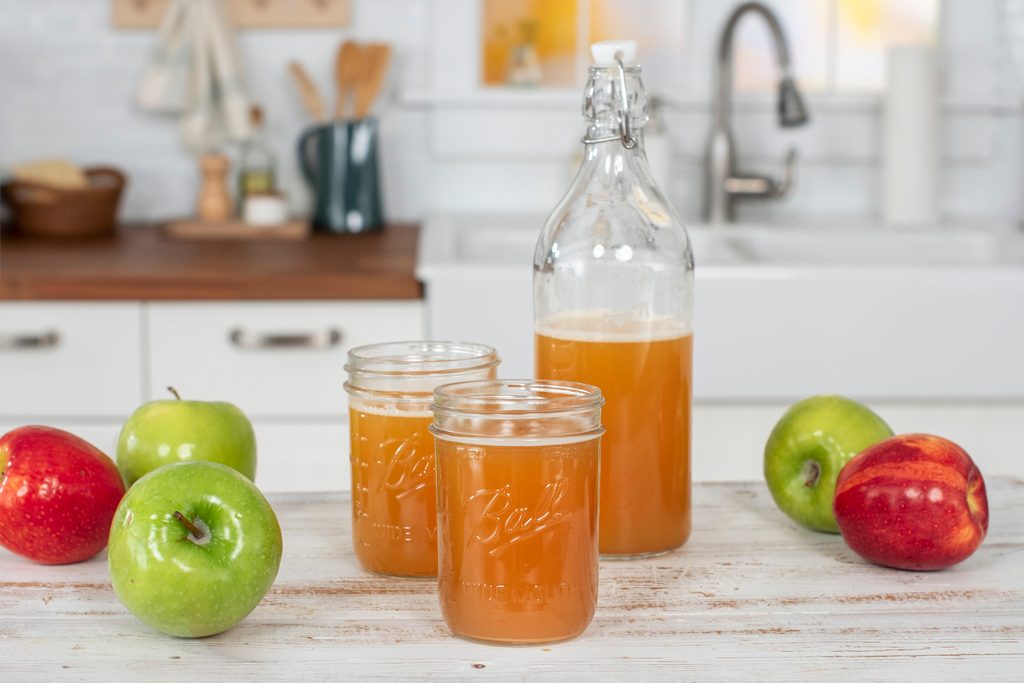How to Make Your Own Hard Apple Cider
Updated: Nov. 28, 2023

Calling all hard apple cider aficionados! Here's where you can learn how to make hard apple cider right at home.
Sweet, bubbly and with just the right amount of tart, hard apple cider is a refreshing alternative when you’re not in the mood for a beer or a glass of wine. Hard apple cider has become so popular in the last few years that it’s become the fastest-growing beverage type in the US.
If you’ve already jumped on the hard apple cider train, then you understand the hype. And while you probably have a go-to brand, have you ever thought about trying to make your own?
Our friends over at Craft A Brew have made cider-lovers’ dreams come true with their Hard Cider Brew Kit ($44). The kit comes with all the equipment needed to ferment and bottle homemade apple cider, all you need to grab is some apple juice and bottles.
Keep reading to learn how to make hard apple cider plus some great tips from James Schend, Taste of Home’s Deputy Editor, who gave the Craft A Brew’s kit a try.
Learn what else you could be doing to upgrade your apple cider.
How to Make Hard Apple Cider
What You’ll Need:
Ingredients:
- 1 gallon preservative-free apple juice
- 1 package active dry yeast (the kit comes with its own package of yeast)
- 2 tablespoons of sugar
Equipment:
- Large pot
- 10 swing-top bottles ($22)
- A Make Your Own Hard Apple Cider kit ($30)
If you don’t pick up a kit, here’s what else you’ll need:
- Bleach
- Funnel
- 1-gallon carboy fermenter ($15)
- Drilled rubber stopper
- Airlock
- Racking cane ($17)
- Transfer tubing
Note: Be sure to check that your carboy, drilled rubber stopper and airlock are coordinating sizes.
Step 1: Sanitize fermenting equipment
To prevent any unwanted flavors from developing in your cider, you’ll want to completely sanitize your equipment to get rid of bacteria. You can do this by adding a tablespoon of bleach to a gallon of water in a bucket. Completely submerge your fermentation equipment (carboy, funnel and rubber stopper) in solution and let it sit for about one minute.
Remove the equipment from the solution, thoroughly rinse off the bleach with cool running water and set the pieces on clean paper towels to dry.
Tip from James: Sanitization is important for more than a great tasting cider, it makes the cider safe to drink. Unwanted bacteria can spore and create botulism, a toxin that causes serious health problems like paralysis or even death. You can read more about botulism and how it can develop, here.
Editor’s Note: The Craft A Brew kit comes with its own sanitizer packet. Only use half of one packet with a gallon of water to sanitize the fermentation equipment. You’ll be able to use the other half a bit later for the bottling equipment.
Step 2: Mix fermentation ingredients
Once your fermentation equipment has dried, use a funnel to pour your apple juice into a carboy fermenter and sprinkle in the dry active yeast.
The type of apple juice you use matters. The more apple varieties that are in the juice, the more complex your apple cider will taste. An apple orchard or farmers market is a great place to get your apple juice for this project. No matter where you get your apple juice, make sure it is free from preservatives (ascorbic acid is fine). Preservatives can prevent fermentation and ruin your hard cider.
Note from James: If you can find it, go with unpasteurized apple juice. It will result in a cider with much more flavor as it hasn’t been previously heat-treated.
Note from James: Once you’ve made a few batches and feel comfortable with the cider-making process, feel free to do some experimenting with your juices. Try substituting about 2 cups of your apple juice with cherry juice, blueberry juice or pear juice for some subtle flavor. But, since the fermentation is where alcohol begins to develop, you’ll want to keep your base fairly basic.
Step 3: Aerate and seal
Insert the drilled rubber stopper in the mouth of the carboy then, using a clean finger or paper towel, cover the rubber stopper’s hole and forcefully shake the juice and yeast for at least a minute. This process aerates the juice and yeast, providing oxygen for a quicker and more complete fermentation process.
Since the fermentation process will create CO2, you’ll want to use an airlock to prevent your carboy from becoming pressurized and cracking. An airlock allows the CO2 to escape while preventing any outside air from entering the carboy.
Remove the cap from the airlock and fill it halfway with water. Then, insert the airlock into the drilled rubber stopper’s hole.
Step 4: Let it rest
Stick your airlocked carboy in a cool, dark place for 10 days.
Step 5: Sanitize bottles and bottling equipment
After your apple cider has fermented, it’s time to bottle! You can use swing top or pry off bottles, but pry off bottles will require additional capping equipment. Either can typically be found in a wine shop or online.
Regardless of which bottle you go with, rinse them out and then sanitize them, along with the racking cane, transfer tubing, funnel and a spoon, following the same process as step 1.
Step 6: Make simple syrup
In order to carbonate the cider, and raise the ABV a bit, you’ll want to make a simple syrup for the remaining yeast to eat. To do so, heat 1 ½ cups of water in a large pot (at least big enough to hold all of the cider and simple syrup) over medium and stir in 2 tablespoons of sugar until it dissolves. Let the mixture boil for about 5 minutes, then remove from heat and let cool.
Note from James: The simple syrup is another great opportunity to add more flavors to your cider. You can boil the simple syrup with a few cinnamon sticks, star anise or any other of your favorite spices to impart their flavor in your cider. Just be sure to remove any of the spices from the syrup before adding it to the cider.
Editor’s note: While using more than 2 tablespoons of sugar for the simple syrup will make the cider sweeter, it could also give the yeast too much sugar to work with. Meaning too much carbonation could develop, resulting in cracked or even exploding bottles. So, stick to 2 tablespoons.
Step 7: Siphon the cider
Grab your tubing, with the clamp open, and submerge it in a bowl of clean water until it has filled with water. Close the clamp and remove the tubing from the water, holding the ends up so none of the water escapes. Attach the racking cane to the open end of the tubing, then place the racking cane in the carboy. You’ll want to insert the racking cane as deeply as you can without touching any of sediment that may have settled at the bottom of the carboy.
Pull the tubing down so it’s lower than the carboy, then open the clamp and allow the water to flow out into a glass. Once the water is out, reclose the clamp and then place your simple syrup pot or some other large bowl under the tubing. Reopen the clamp and let all of the cider flow out of the carboy.
Step 8: Combine cider and simple syrup
If you didn’t siphon the cider directly into the simple syrup pot, combine the two and then use the sanitized spoon to gently stir the pot. You’ll want to make sure that the simple syrup dissolves completely into the cider and that there are no globs of syrup.
Step 9: Siphon into bottles
Repeat step 7 to set up a siphon to transfer the cider from the pot and into your 10 bottles. You’ll want to fill each bottle just above the start of the neck, leaving some room for carbonation to form.
Step 10: Carbonate bottles
Securely close your swing top bottles or cap pry off bottles with capping equipment. Wipe down the bottles and then store them in a dark, dry place for an additional 10 days.
Step 11: Chill and enjoy
After 10 days, transfer your bottles to a refrigerator. Once the cider has cooled, pop a bottle open and enjoy your homemade brew! You can garnish your drink with some freshly-cut apples – but first, learn how to keep apples from browning.
